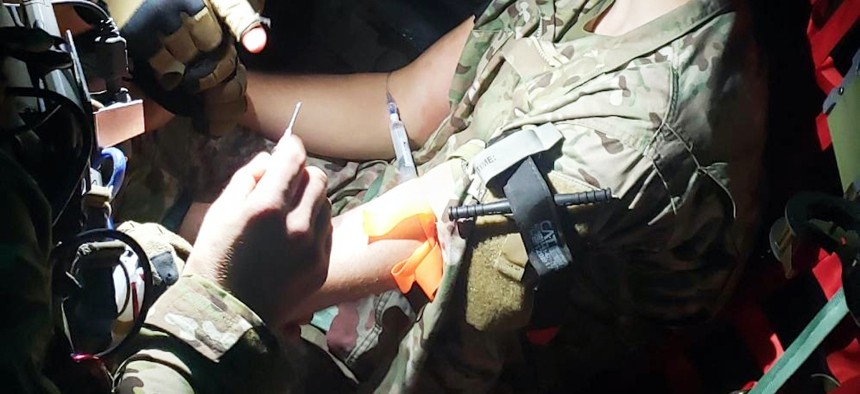
Tactical Medical Augmentation Team Airmen administer patient care to a simulated patient during a mass casualty exercise aboard an HC-130J Combat King II aircraft. 920th Rescue Wing Public Affairs
The Air & Space Brief: Military intelligence wants to help navigate; C-130H still grounded; Space Ops worried about cyber ‘underbelly,’ and more
Welcome to the Defense One Air and Space newsletter. Here are our top stories this week:
Access granted. U.S. officials “are looking for ways to give companies more access to military intelligence and technologies that would allow them to fly and sail in areas where civilian networks and navigation satellites are blocked,” Defense One’s Marcus Weisgerber reports. Gen. Jacqueline Van Ovost, head of U.S. Transportation Command, said the effort is necessary to prepare for a possible future war in the Pacific, in which the military would need commercial airlines and shipping companies to move troops and supplies.
Still grounded: Only two of the 116 C-130Hs grounded by the Air Force on Sept. 27 have returned to the air so far, Air Force Times reports. The service stopped flying much of its C-130H fleet after crews found cracks in some of the mobility aircraft’s propeller barrel assemblies. Air Force Reserve and Air National Guard units have been impacted the most by the groundings, Air Force Times writes.
National Security Strategy: The White House on Wednesday released a new NSS, which—like its 2017 predecessor—focuses on China as a “pacing challenge,” but also downgrades the Russian threat to “acute,” Defense One’s Patrick Tucker reports. It downgrades threats from the Middle East and global terrorism even more. The strategy’s release was delayed by Russia’s invasion of Ukraine, but the way that invasion has unfolded has vindicated the administration’s methodical approach, National Security Advisor Jake Sullivan said.
Cyber vulnerabilities: Cybersecurity is “really the soft underbelly of these global space networks,” and the Space Force must pay more attention to its cyber vulnerabilities, Lt. Gen. Stephen Whiting, head of Space Operations Command, said Friday, according to Air & Space Forces Magazine. “We don’t yet have the intuitive understanding to say, based on the threat that we’re seeing, ‘Have we done enough?’” Whiting said. “I don’t want to act like we don’t have any of those tools, but it’s not the same comprehensive understanding we have for physical security.”
Sign up to get The Air & Space Brief every Tuesday from Jennifer Hlad, Defense One’s news editor. Seventy-five years ago, on Oct. 14, 1947, Air Force Capt. Charles “Chuck” Yeager broke the sound barrier in the XS-1 Glamorous Glennis.
 From Defense One
From Defense One
Commercial Planes, Ships Would Play Large Role in Pacific War, TRANSCOM Head Says // Marcus Weisgerber
Last year's massive Afghanistan evacuation could be a trial for how the military moves troops and equipment around the future battlefield.
New National Security Strategy Returns Focus to Rules, Partnerships, and American Leadership // Patrick Tucker
China is a "pacing" threat, Russia just an "acute" one—but international partnerships, the old global order are key to beating both.
The Ukraine War Is Teaching the US How to Move Intelligence Faster // Patrick Tucker
Part of it is better planning, part is new AI-assisted tools.




